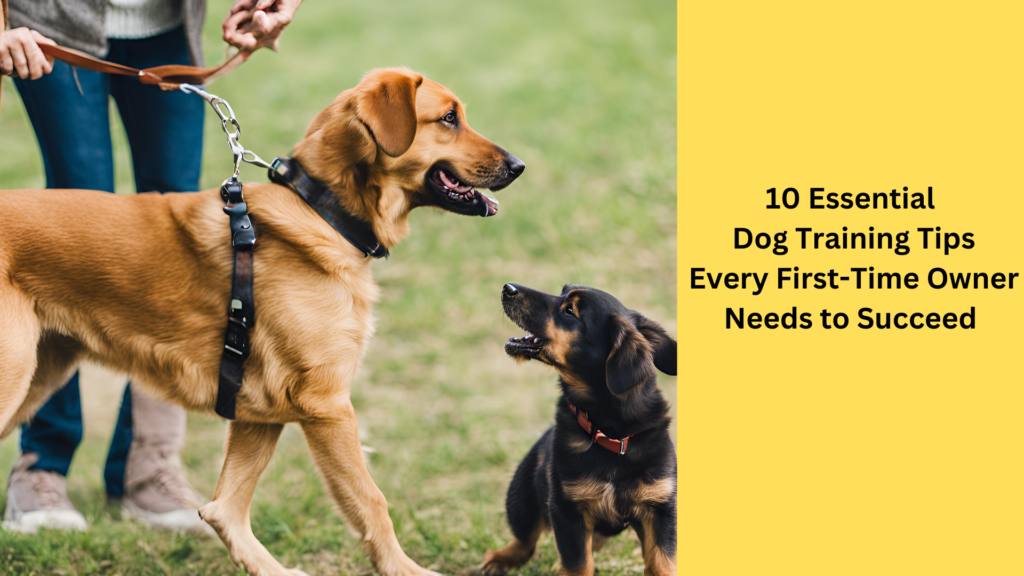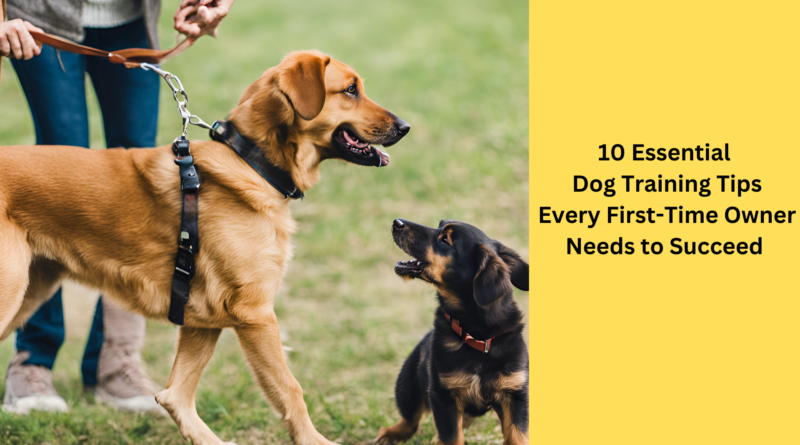10 Essential Dog Training Tips Every First-Time Owner Needs to Succeed
Training your dog is one of the most rewarding aspects of being a pet owner. It not only strengthens the bond between you and your furry friend but also ensures they grow into well-behaved and happy companions. As a first-time dog owner, it’s crucial to start with the right training techniques to set your pet up for success. In this article, we’ll cover 10 essential dog training tips that every first-time owner needs to know. These tips are designed to be simple, effective, and easy to implement, helping you and your dog enjoy a harmonious life together.

1. Start Training Early
The earlier you begin training your dog, the better. Puppies are like sponges, absorbing information and learning quickly during their formative months. However, it’s never too late to train an older dog; it just might take a bit more patience and consistency.
Key Points:
- Ideal Age: Begin training when your puppy is 8-12 weeks old.
- Foundation Skills: Focus on basic commands like sit, stay, and come.
- Socialization: Expose your dog to different environments, people, and other pets to reduce fear and anxiety later in life.
Why Early Training Matters?
Early training helps prevent behavioral issues before they arise. It also establishes a foundation of trust and communication between you and your dog. Puppies who undergo early training are more likely to adapt to new situations, making them confident and well-adjusted adults. If you’ve adopted an older dog, start with patience and positive reinforcement to help them unlearn any bad habits and develop new, healthy ones.
2. Use Positive Reinforcement
Positive reinforcement is one of the most effective methods for training dogs. Rewarding your dog for good behavior encourages them to repeat those actions in the future.
How to Implement:
- Rewards: Use treats, praise, or toys to reward desired behavior.
- Timing: Deliver rewards immediately after the correct behavior to reinforce the connection.
- Consistency: Be consistent with your rewards to avoid confusing your dog.
The Science Behind Positive Reinforcement:
Studies show that dogs trained using positive reinforcement learn faster and retain their training better than those trained with punishment-based methods. This approach fosters trust and strengthens the bond between you and your dog. Avoid yelling or using harsh punishments, as these can lead to fear and anxiety, making training more difficult.
3. Be Consistent with Commands
Consistency is key when training your dog. Using the same commands and hand signals ensures your dog understands what you’re asking of them.
Tips for Consistency:
- Stick to One Word: Use single-word commands like “sit,” “stay,” or “come.”
- Involve the Family: Ensure everyone in your household uses the same commands and training techniques.
- Daily Practice: Practice commands daily to reinforce learning.
Common Mistakes to Avoid:
- Changing the command words frequently.
- Expecting your dog to know commands they haven’t been taught consistently.
- Failing to follow through with commands, which can confuse your dog and hinder their progress.
READ ALSO: Top 10 Best Dog Breeds for First-Time Owners: A Beginner-Friendly Guide
4. Keep Training Sessions Short and Fun
Dogs have short attention spans, especially puppies. Keeping training sessions brief and engaging helps maintain their focus and enthusiasm.
Best Practices:
- Duration: Limit sessions to 5-10 minutes for puppies and 15-20 minutes for adult dogs.
- Frequency: Train multiple times a day for consistent reinforcement.
- Make It Fun: Incorporate playtime and rewards to keep your dog motivated.
Why Short Sessions Work:
Overloading your dog with long training sessions can lead to boredom and frustration. Short, focused sessions allow your dog to stay engaged and excited about learning. Break up training into multiple mini-sessions throughout the day to reinforce lessons without overwhelming your pet.
5. Focus on Basic Commands First
Teaching your dog basic commands lays the foundation for more advanced training and good behavior. These commands are essential for their safety and your peace of mind.
Must-Know Commands:
- Sit: Helps calm your dog in various situations.
- Stay: Prevents your dog from running into dangerous situations.
- Come: Ensures your dog returns to you when called.
- Leave It: Teaches your dog to ignore items or food that could be harmful.
Expanding Beyond Basics:
Once your dog has mastered basic commands, you can move on to more advanced tricks and behaviors. Advanced training keeps your dog mentally stimulated and strengthens your bond. Examples include teaching your dog to retrieve items, perform agility exercises, or learn fun tricks like rolling over or playing dead.
6. Use Crate Training for Safety and Comfort
Crate training is an excellent way to provide your dog with a safe and comfortable space. It also helps with housebreaking and reduces anxiety.
How to Crate Train:
- Introduce the Crate: Make it a positive space with toys and treats.
- Start Slow: Gradually increase the time your dog spends in the crate.
- Never Use as Punishment: Ensure the crate remains a safe and comforting environment.
Benefits of Crate Training:
Crate training can help prevent destructive behavior when you’re not home. It also provides your dog with a den-like space where they feel secure. For puppies, it’s an invaluable tool for housebreaking, as dogs naturally avoid soiling their sleeping area.
7. Be Patient and Persistent
Training takes time, and every dog learns at their own pace. Patience and persistence are essential to avoid frustration for both you and your dog.
Tips for Staying Patient:
- Avoid Punishment: Focus on rewarding good behavior rather than punishing mistakes.
- Stay Calm: Dogs can sense your emotions, so stay calm and encouraging.
- Celebrate Progress: Even small improvements are worth celebrating.
Why Patience Pays Off:
Training is a journey, not a race. By staying patient and consistent, you’ll help your dog build confidence and trust in you. Remember, setbacks are normal; view them as opportunities to reinforce training and grow closer to your dog.
8. Socialize Your Dog
Socialization is a critical aspect of training that helps your dog become well-adjusted and confident. Proper socialization reduces the likelihood of fear or aggression in unfamiliar situations.
Socialization Strategies:
- Exposure: Introduce your dog to various environments, people, and animals.
- Start Early: Begin socialization during the puppy stage, ideally before 16 weeks of age.
- Controlled Interactions: Ensure interactions are positive and safe.
Socialization Activities:
Take your dog on walks in busy areas, visit dog-friendly parks, and invite friends over to meet your pet. Enroll in puppy classes to expose your dog to other dogs in a controlled setting. Proper socialization builds a confident, well-behaved dog.
9. Address Behavioral Issues Early
Addressing behavioral problems early prevents them from becoming ingrained habits. Common issues like barking, chewing, and jumping can be resolved with the right training techniques.
Steps to Correct Behavior:
- Identify the Cause: Determine if the behavior stems from boredom, fear, or lack of training.
- Redirect Behavior: Provide alternative actions, like giving a chew toy instead of allowing destructive chewing.
- Reward Good Behavior: Reinforce positive actions with treats and praise.
Tools to Help:
Consider using clickers, chew toys, or puzzle feeders to redirect energy and encourage positive behaviors. Professional trainers or behaviorists can also provide tailored advice for persistent issues.
10. Seek Professional Help When Needed
Sometimes, training challenges require the expertise of a professional dog trainer or behaviorist. Don’t hesitate to seek help if you’re struggling to address specific issues.
When to Consult a Professional:
- Persistent Problems: Issues like aggression or severe anxiety.
- Advanced Training: Teaching complex commands or behaviors.
- Guidance for New Owners: Professional trainers can provide valuable insights for first-time owners.
Benefits of Professional Training:
A professional trainer can identify subtle cues and tailor training methods to your dog’s unique needs. Group classes also provide opportunities for socialization while teaching basic commands.
Bonus Tips for Successful Dog Training
Maintain a Routine:
Dogs thrive on routine. Establish a consistent schedule for feeding, walks, and training sessions.
Use Hand Signals:
Pairing verbal commands with hand signals enhances communication and understanding.
Avoid Overtraining:
Give your dog breaks to prevent burnout and ensure they remain enthusiastic about training.
Build Trust:
Always approach training with kindness and patience. Trust is the foundation of a strong bond with your dog.
Conclusion
Training your dog is a journey that requires patience, consistency, and love. By implementing these 10 essential dog training tips, you’ll set your furry friend up for a lifetime of good behavior and happiness. Remember, every dog is unique, so tailor your training methods to suit their personality and needs. With dedication and effort, you’ll not only have a well-behaved companion but also a deeper bond with your new best friend. Whether you’re teaching basic commands or addressing specific behaviors, every step of the training process brings you closer to understanding.

